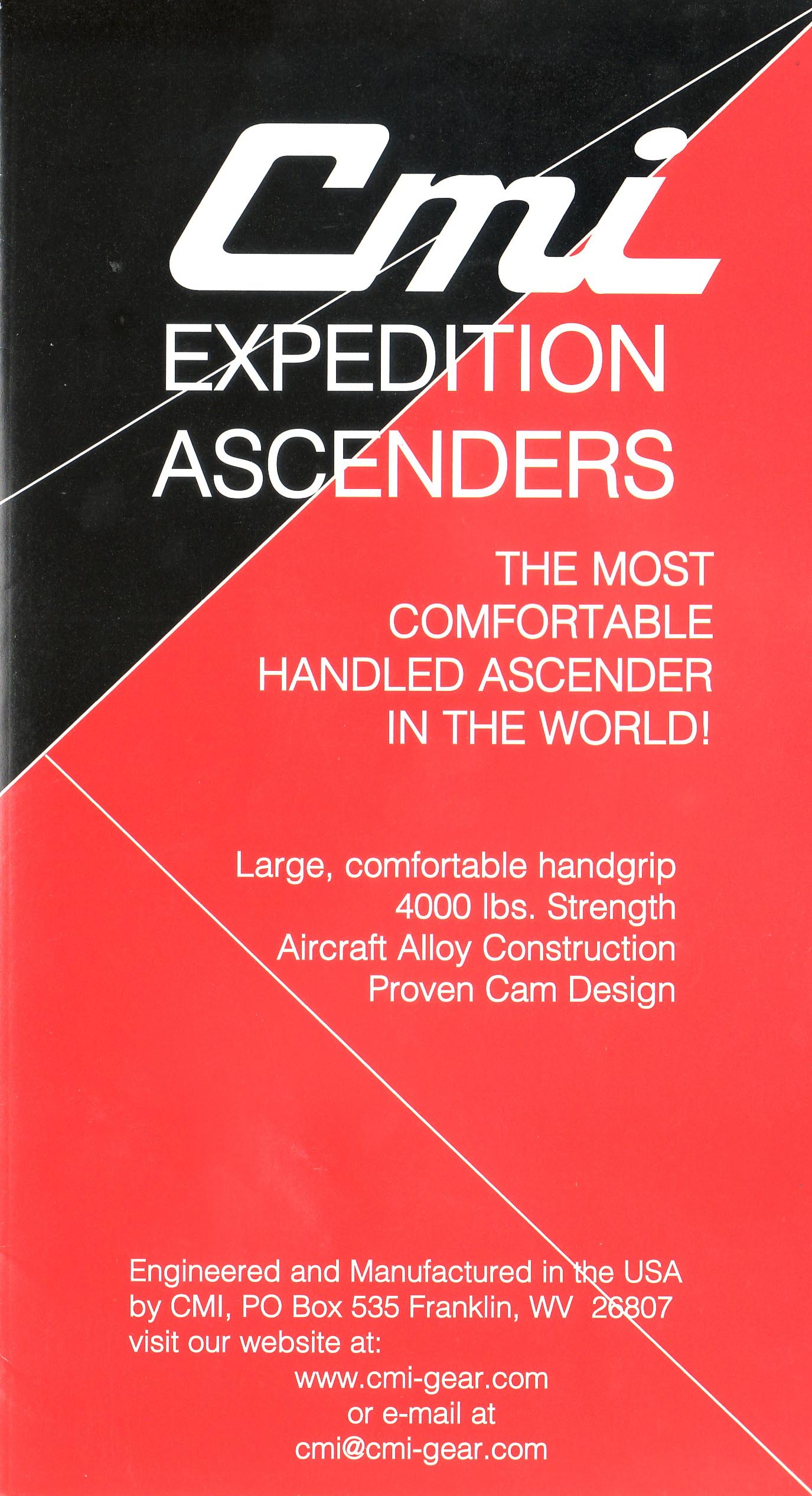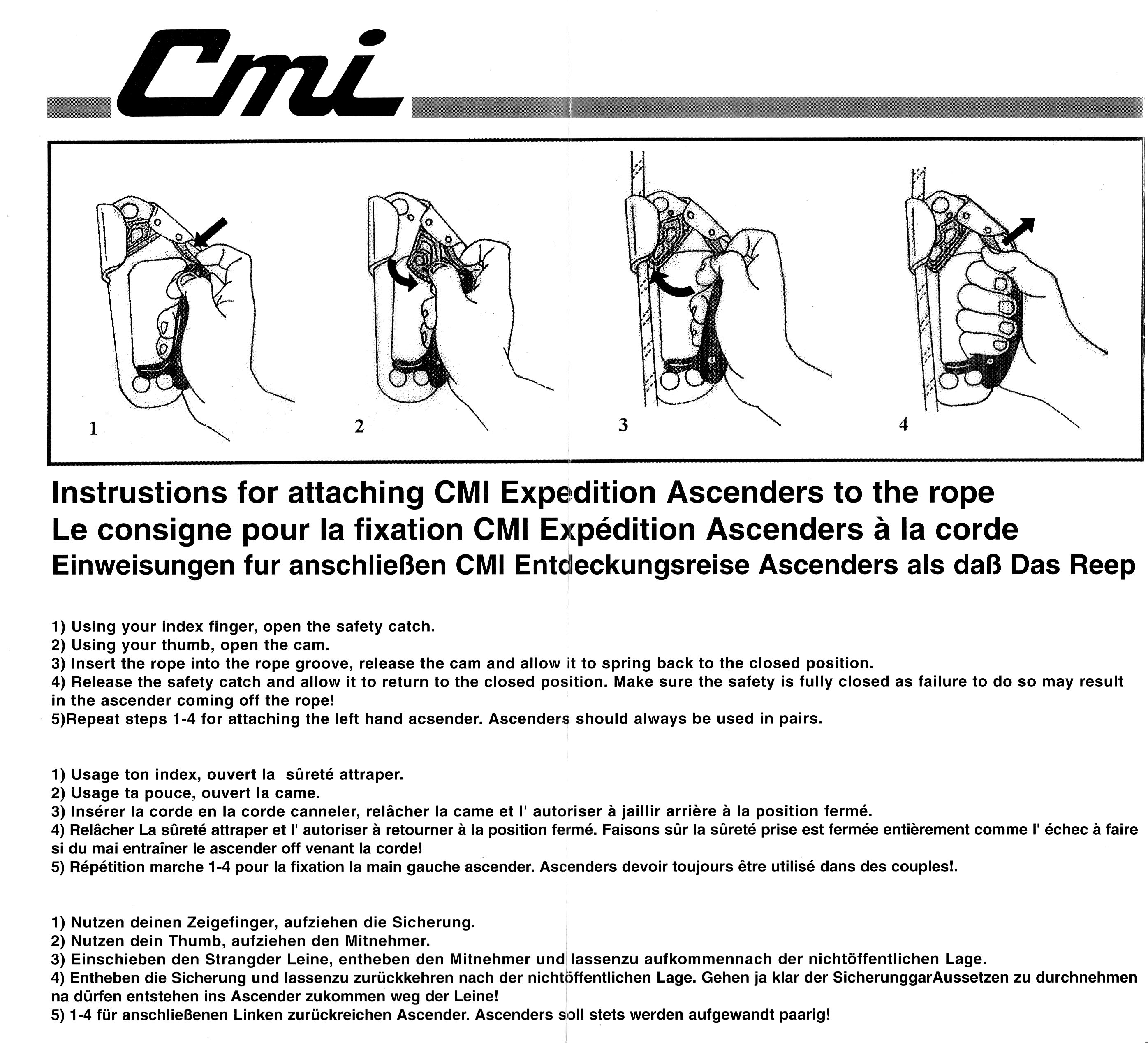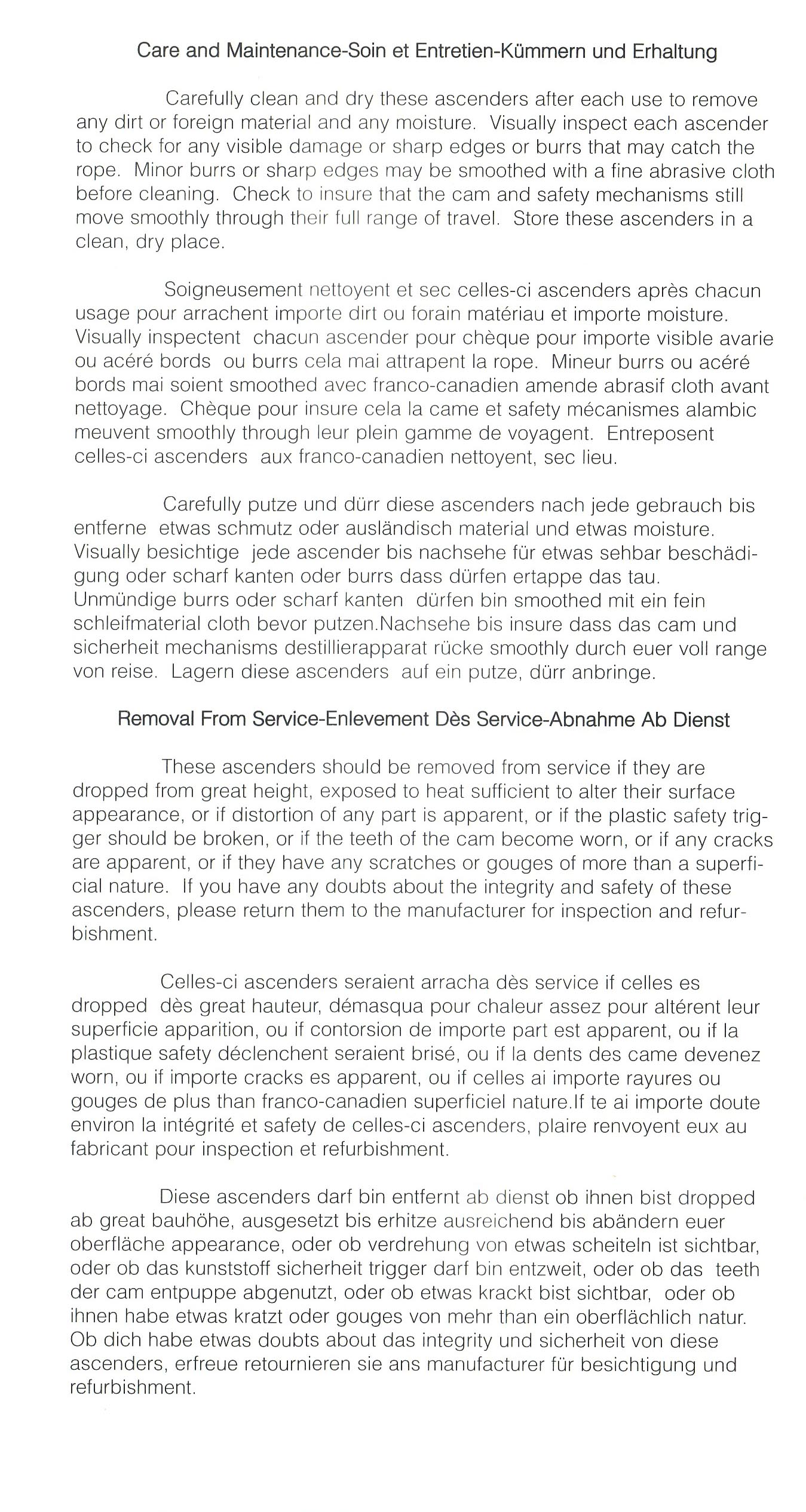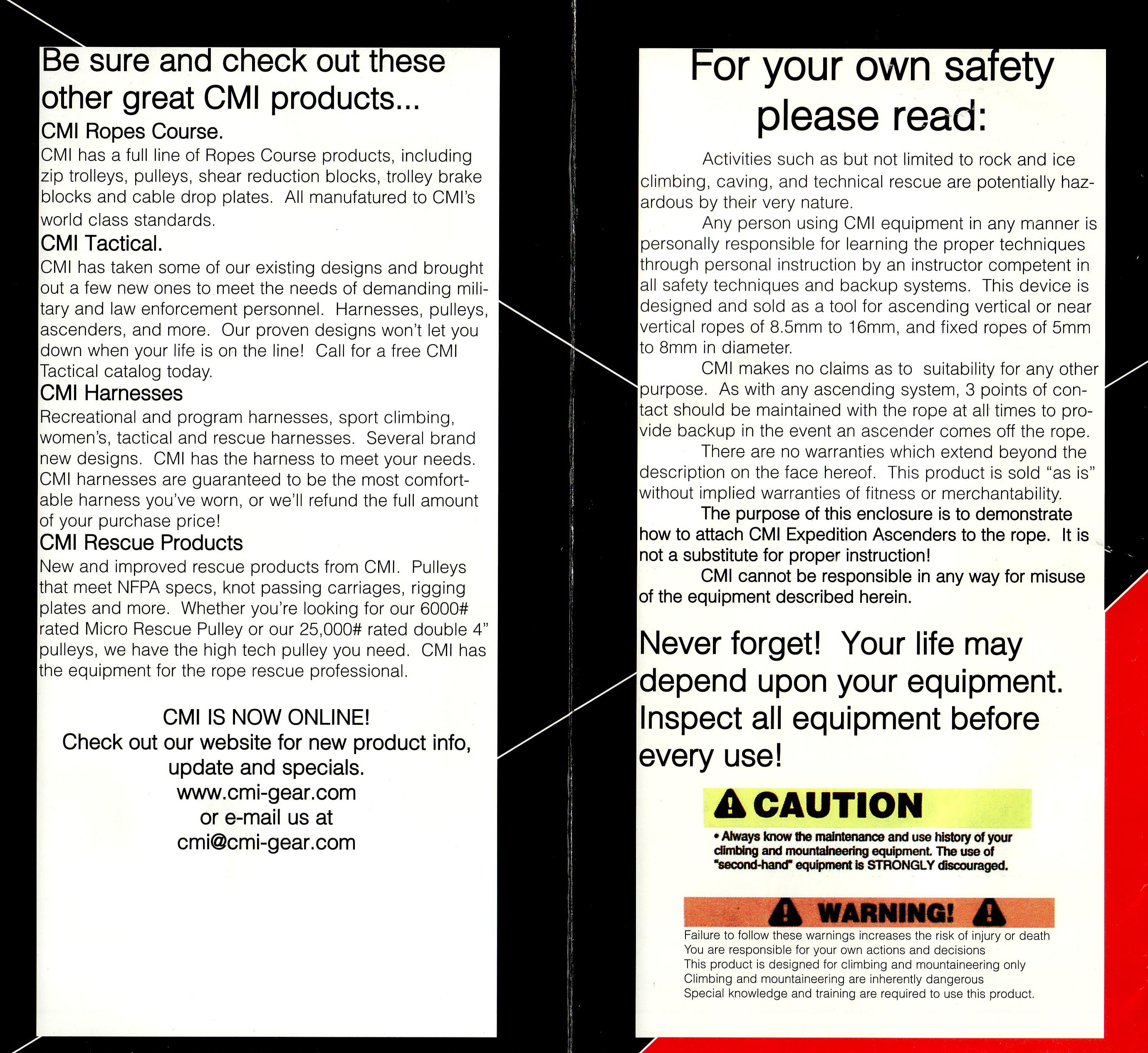Overview
[ Top
| Version B
| Return to H.E.C. Ascenders
]
Version A
(#239, 2227)
Technical Details
I acquired my CMI Expedition Double, Version A new on eBay from
Ed Yazzie in 2008. I acquired another in 2017 as part of Bob Thrun’s collection.
Version A is 208 mm. tall, 178 mm. wide,
and 35 mm. thick. Mine weighs 392 g. It consists of a standard
CMI Expedition ascender with a side
handle attached by two button-head socket cap screws and hex
nuts. The following gray text describes the ascender:
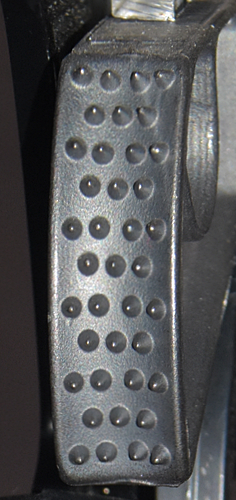 The ascender shell is a roughly "D"
shaped piece of painted 4.2 mm. thick aluminum bent to form
a rope groove on one side and to hold the cam pivot and safety
on the other. The handle opening is 106 mm. high and 55 mm.
wide. There is a two-piece plastic hand grip bolted to the shell
with three 4.6 mm. cap screws and hex nuts. The left rear and right
front hand grips have round recesses for the cap screws, and hex
nuts fit into hexagonal recesses molded into the left front and
right rear hand pieces. Two 15.9 mm. holes at the base of
the shell serve as a rope attachment points. A third 15.9 mm.
hole provides a means to attach non-load-bearing slings to the
shell above the cam.
The ascender shell is a roughly "D"
shaped piece of painted 4.2 mm. thick aluminum bent to form
a rope groove on one side and to hold the cam pivot and safety
on the other. The handle opening is 106 mm. high and 55 mm.
wide. There is a two-piece plastic hand grip bolted to the shell
with three 4.6 mm. cap screws and hex nuts. The left rear and right
front hand grips have round recesses for the cap screws, and hex
nuts fit into hexagonal recesses molded into the left front and
right rear hand pieces. Two 15.9 mm. holes at the base of
the shell serve as a rope attachment points. A third 15.9 mm.
hole provides a means to attach non-load-bearing slings to the
shell above the cam.
The cam is a skeletonized steel casting.
The conical teeth are oriented perpendicular to the cam face and
are set in a (4.3)^3(4) pattern. The inner cam face radius reduces
from top to bottom to accommodate various sized ropes. The cam
and cam spring are mounted on a solid 6.3 mm. steel pin.
An external retaining ring holds the pin in place. The cam safety
is a plastic lever mounted on a 3 mm. semi-tubular rivet in the same
shell channel as the cam. A second spring serves as a safety spring.
Normally this spring holds the safety where it blocks the cam
from opening. When the end of the safety lever is depressed, the
opposite end pivots upwards so that the cam is no longer obstructed.
The side handle is a flat piece of painted, 4.2 mm. thick
aluminum. It has a large hand hole, but no rope holes. The plastic
hand grip is identical to the one on the main ascender.
There are no markings on the ascender, but CMI applied two
stickers. One on the ascender reads "EXPEDITION ASCENDER,"
"Cmi," "Franklin, WV 26807," and "MBS:
3400lb (20.4 Kn)." The other is on the side handle and merely
reads "TESTED."
I don't consider this ascender as the most suitable choice
suitable for mainstream caving (but perhaps some frogger might
choose it) or climbing, so what is it good for? I think it was
designed for the arborist community, and I'm not a Tarzan, so
it would not be right for me to discuss their techniques. Maybe
the arborists will discuss it on one of their web sites. The Kong Twin has a dual handle as well, but
weighs more and does not seem quite as sturdy (it uses 3.4 mm.
aluminum instead of 4.2 mm.). Another similar ascender is
the old Kong-Bonaiti Modular with Dual Handle.
These ascenders came with the brochure for the CMI Expedition ascender, which does not mention the dual handle.
As for the stickers, 3400 lb. is 15.1 kN, not 20.4 kN. This was corrected on later stickers.
[ Top
| Version A
| Return to H.E.C. Ascenders
]
Version B
(#3438)
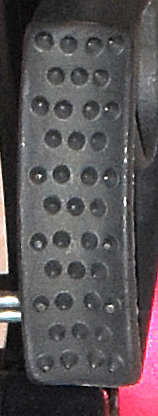 Technical Details
Technical Details
I acquired my CMI Expedition Double, Version B from CMI in 2021.
Version B is 208 mm. tall, 179 mm. wide, 38 mm. thick, and weighs 403 g. The rope channel is 17 mm. wide. The pivot is centered 53 mm. from the inside of the rope channel. The cam radius increases from 41 to 57 mm. over an angle of 42°, giving a 25° cam angle. The tooth pattern is (4.3)^5(4).
Version B makes two changes to Version A. First, Version B adds a spring-ball pin that can be placed through a new hole pair through the cam channel to block the safety so that it cannot be depressed to open the cam. Two split rings and a four-link flat chain act as a pin keeper. Second, the safety is made of anodized aluminum instead of plastic.
There are no markings on the ascender, but CMI applied a sticker that
reads "TESTED."
I don't see a need for the pin blocking the safety, since it makes attaching and removing the ascender from the rope more difficult than necessary. On the other hand, this ascender was designed for arborists, not cavers. Arborists work where the rope is often running in strange directions that cavers are less likely to encounter, so perhaps they have a need for this feature - how would I know?
I like the aluminum safety, although I see nothing wrong with the older plastic safety.
[ Top
| Version A
| Version B
]



